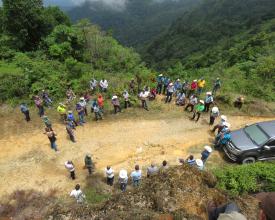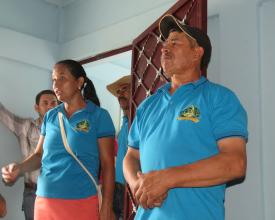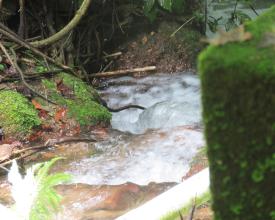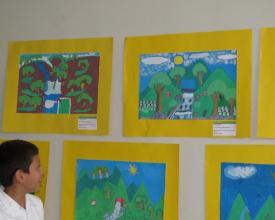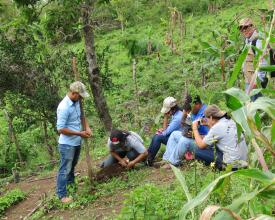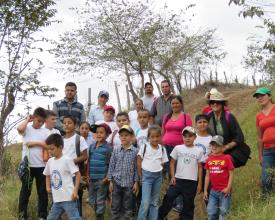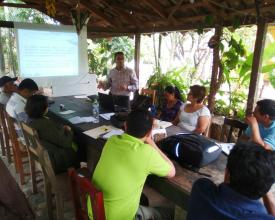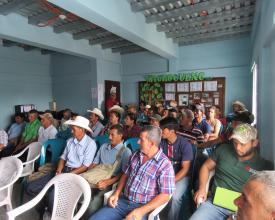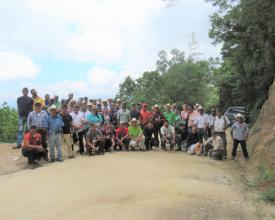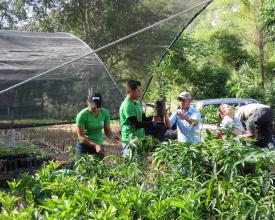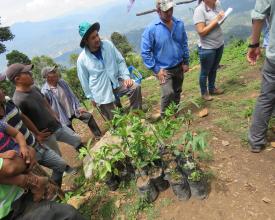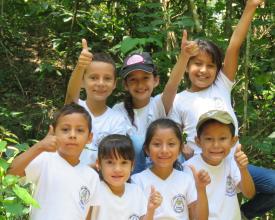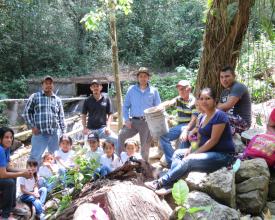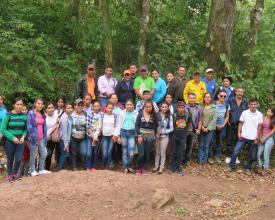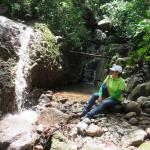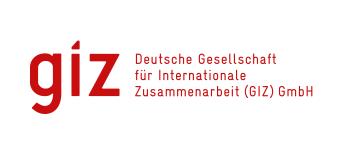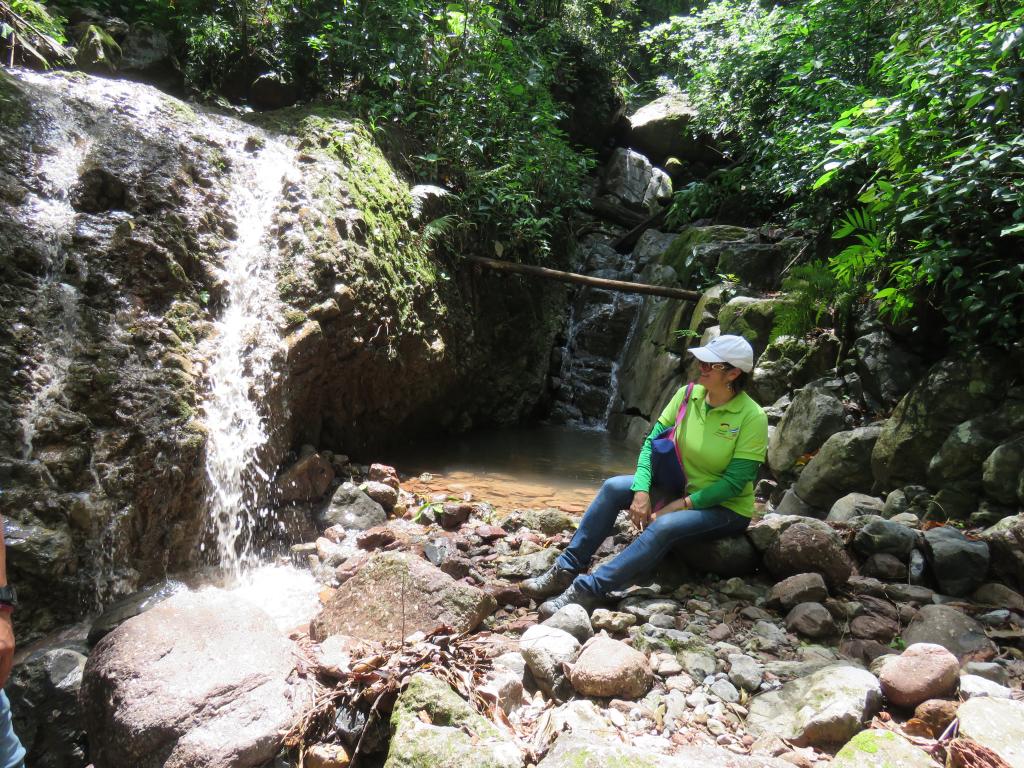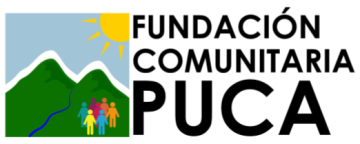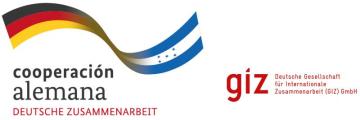
Güergüerense : un cas réussi de participation communautaire à la restauration d'un micro-bassin versant
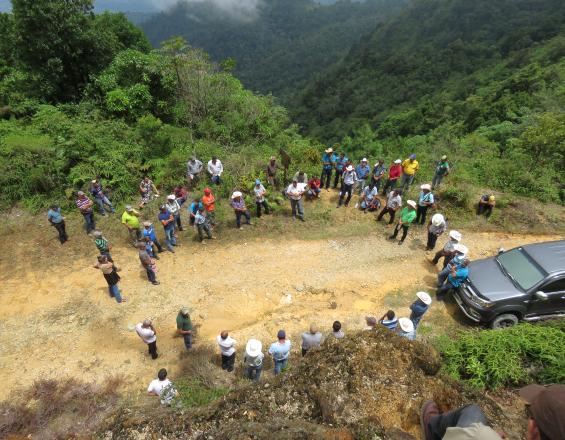
Il y a cinq ans, la déforestation dans la partie supérieure du micro-bassin versant de Güergüerense a alerté la population de la municipalité de Las Flores que quelque chose n'allait pas avec l'écoulement de l'eau dans cette zone située dans la réserve de biosphère Cacique Lempira Señor de las Montañas (RBCLSM) dans l'ouest du Honduras.
L'extension de la frontière agricole a déclenché l'alerte et la recherche d'une solution, car ces pratiques menacent non seulement les zones de recharge de l'eau, mais aussi la zone centrale de la zone protégée.
Voici comment les agences de l'eau, les autorités nationales, les gouvernements locaux, les organisations de la société civile et la coopération internationale ont articulé des actions pour la mise en œuvre d'un mécanisme de compensation pour les services écosystémiques et hydrologiques (MCSEH), afin de garantir l'approvisionnement en eau de la région.
Contexte
Défis à relever
Afin de récupérer la couverture forestière et d'augmenter l'approvisionnement en eau, les communautés entourant le micro-bassin hydrographique ont dû relever les défis suivants :
- Récupérer 70 % de l'écosystème du micro-bassin, c'est-à-dire récupérer la forêt déboisée en raison de l'agriculture extensive et de l'élevage de bétail.
- Renforcer les huit conseils de l'eau, les organisations communautaires ayant été affaiblies ces dernières années.
- Sensibiliser les communautés aux problèmes environnementaux qui se poseraient si la déforestation dans la partie supérieure du micro-bassin n'était pas stoppée.
Emplacement
Traiter
Résumé du processus
Travailler sur l'approche et la mise en œuvre du Mécanisme de compensation pour les services écosystémiques liés à l'eau (MCSEH) avec la participation des communautés est la clé pour responsabiliser les communautés et s'assurer qu'elles s'approprient le mécanisme.
Les communautés entourant le micro-bassin versant de Güergüerense sont un exemple clair de coordination entre les autorités locales, les organisations de base, les centres éducatifs, les organisations non gouvernementales et les organisations de la société civile, ainsi que les agences de coopération internationale, qui unissent leurs forces pour garantir la gestion des ressources en eau.
Pour générer des changements de comportement, il est essentiel de développer des actions de restauration et de protection des micro-bassins versants qui stimulent la participation des citoyens, telles que des journées de nettoyage, la collecte et la classification des déchets solides, des campagnes de reboisement, des visites, des conférences et des concours de dessin. En bref, il s'agit d'éduquer et de sensibiliser les communautés à l'importance des micro-bassins versants pour la vie des êtres humains et pour la biodiversité de la réserve de biosphère Cacique Lempira Señor de las Montañas.
Blocs de construction
Le début de la récupération du micro-bassin versant
Le processus de responsabilisation des acteurs a commencé par des visites d'échange organisées par la Fondation communautaire Puca, l'Institut de conservation des forêts (ICF) et la municipalité de Las Flores avec le soutien du projet PROCAMBIO, mis en œuvre par la GIZ.
Ces échanges ont eu lieu dans les micro-bassins versants de Las Balanzas (dans la réserve biologique de Güisayote) et de Río Hondo (dans la municipalité de San Marcos), tous deux dans le département d'Ocotepeque, où un fonds vert et le mécanisme de compensation pour les services écosystémiques liés à l'eau (MCSEH) ont été mis en œuvre.
Facteurs favorables
- Les communautés étaient conscientes qu'il était nécessaire de commencer à protéger le micro-bassin versant si elles voulaient garantir leur approvisionnement en eau.
- La communication entre les organisations de base et les autorités et institutions municipales présentes sur le territoire a permis une coordination adéquate.
Leçon apprise
- L'expérience des agences de l'eau des micro-bassins versants de Las Balanzas et de Rio Hondo a permis d'identifier la manière de résoudre les principaux problèmes liés à la mise en œuvre du mécanisme de compensation et du fonds vert.
- La coordination interinstitutionnelle est essentielle pour garantir la participation de toutes les organisations et de tous les acteurs impliqués dans le processus.
Fond vert
Le Fonds vert ou Fonds environnemental fait partie du Mécanisme de compensation pour les services écosystémiques de l'eau (MCSEH) et est créé grâce à la contribution financière des abonnés à l'eau dans les communautés, qui, outre le paiement de la redevance mensuelle pour le service d'eau potable, versent un excédent destiné exclusivement à la gestion environnementale dans le micro-bassin hydrographique.
Les autres contributeurs à ce fonds sont la municipalité, les communautés, les entreprises privées et la coopération internationale. Dans le cas du Fonds vert de Güergüerense, sa création signifie des ressources économiques pour l'achat de terres dans le micro-bassin hydrographique qui seront utilisées pour la régénération et le reboisement de la forêt.
Facteurs favorables
- L'ensemble de la corporation municipale a démontré son engagement envers la population et la ressource en eau en approuvant la création de ce fonds, en établissant une contribution de 50 %, tandis que les communautés ont affecté les 50 % restants à l'achat de terrains.
- Le fonds environnemental est également destiné à la clôture des prises d'eau, à l'analyse de la qualité de l'eau et au jaugeage.
Leçon apprise
- Une stratégie de sensibilisation des familles propriétaires de terrains adjacents au micro-bassin versant, destinés à la culture ou à l'élevage, a été mise en place et ces terrains ont été acquis pour le reboisement et la régénération de la forêt.
- La régénération naturelle contribue à garantir l'approvisionnement en eau de la municipalité, c'est pourquoi il est nécessaire de clôturer les terres pour garantir l'approvisionnement en eau.
- Les zones situées autour du micro-bassin versant ont été reboisées avec du bois et des arbres fruitiers.
Éducation à l'environnement
Une stratégie d'éducation à l'environnement a été mise en œuvre pour sensibiliser la population à l'importance de la restauration et de la protection du micro-bassin hydrographique. À cette fin, en collaboration avec la fondation communautaire Puca, des visites du micro-bassin versant ont été organisées avec différents groupes de la population. En outre, des réunions ouvertes ont été organisées par la municipalité de Las Flores sur les questions environnementales et la participation des femmes à la gestion des ressources naturelles, entre autres.
Facteurs favorables
- La participation des écoles par le biais de réseaux éducatifs a favorisé la sensibilisation à l'environnement non seulement des élèves de tous âges, mais aussi de leurs familles qui ont participé aux visites environnementales du micro-bassin hydrographique.
- Les conseils municipaux sont un excellent moyen de faire participer les citoyens à la gestion des ressources naturelles.
- La volonté et le désir des communautés de restaurer le micro-bassin versant ont contribué au succès de la mise en œuvre du mécanisme de compensation des services écosystémiques pour l'eau (MCSEH).
Leçon apprise
- Les journées d'éducation à l'environnement dans les micro-bassins versants, les réunions du conseil municipal et les assemblées communautaires sont des instruments qui permettent de sensibiliser la population à l'importance des ressources naturelles et de lui donner les moyens d'agir.
- Il est important, dans les processus d'éducation à l'environnement, que les citoyens participent pleinement, depuis tous les groupes impliqués dans la stratégie jusqu'à la population en général.
Impacts
Un mécanisme de compensation pour les services écosystémiques liés à l'eau (MCSEH) a été mis en place et un fonds vert ou fonds environnemental a été créé, avec lequel des terres sont achetées dans les micro-bassins versants pour la régénération des forêts et le reboisement.
Des processus de renforcement des capacités, des réunions du conseil municipal et des assemblées communautaires ont été organisés, avec la participation des agences de l'eau, des propriétaires fonciers des micro-bassins versants, des producteurs, des éleveurs, des techniciens des organisations impliquées et de la population en général.
En outre, des activités d'éducation à l'environnement ont été menées avec les agences de l'eau, les étudiants, les enseignants, les réseaux de jeunes et les producteurs.
Les autorités municipales ont été coordonnées avec les bases communautaires par le biais de processus de communication clairs et directs, dans lesquels la coordination des actions a été recherchée pour garantir la restauration de la couverture forestière dans le micro-bassin hydrographique.
Des visites d'échange ont été organisées dans d'autres micro-bassins versants de l'ouest du Honduras, où les conseils de l'eau du micro-bassin versant de Güergüerense ont pris connaissance des défis rencontrés par leurs pairs lorsqu'ils ont commencé à travailler sur la protection de leurs micro-bassins versants.
Bénéficiaires
Quelque 5 000 personnes, issues des communautés suivantes, sont approvisionnées en eau :
1. Casco Urbano
2. Coalaca
3. Mongual
4. La Cañada
5. Piedra Pintada
6. El Copante
7. Guanás Arriba
8. Guanas Abajo
Objectifs de développement durable
Histoire
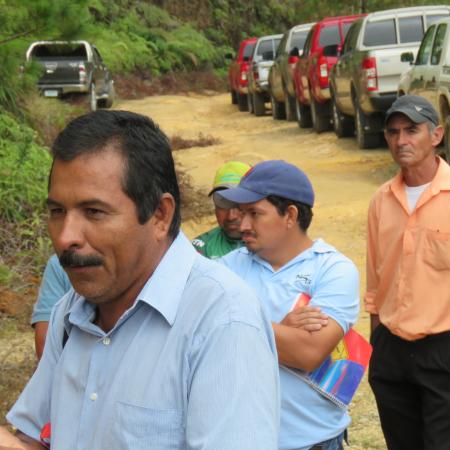
La déforestation pour la culture du café et des céréales de base, ainsi que pour l'élevage, était évidente. En outre, le débit d'eau avait commencé à diminuer, affectant non seulement la population du centre urbain de la municipalité, mais aussi les huit communautés qui tirent leur eau du micro-bassin hydrographique, a rappelé Mario Torres, président de l'association des conseils municipaux de Güergüerense.
Comme dans la plupart des municipalités du territoire, les céréales de base et le café sont les principales cultures de la zone tampon du refuge de la Montaña de Puca (RVSMP), l'une des trois zones protégées qui composent la réserve de biosphère.
"La population devait prendre conscience de ce que signifiait la protection du micro-bassin hydrographique, car si l'on n'agissait pas immédiatement, les communautés manqueraient d'eau", a déclaré Paulino Argueta, vice-président de l'Association de l'eau de Güergüerense.
Pour sa part, Dora Luz Pineda, trésorière de la commission de l'eau de la communauté de Guanas Abajo, a déclaré que la participation des femmes est importante dans ces processus car "les femmes sont conscientes qu'elles ont besoin d'eau pour mener à bien toutes les activités dans leurs foyers, il est donc nécessaire que nous nous impliquions dans les commissions de l'eau, que nous sachions comment l'eau arrive du micro-bassin vers nos cuisines, nous devons savoir comment l'utiliser et l'entretenir de manière optimale".
C'est pourquoi des processus de renforcement des capacités, des réunions du conseil municipal et des assemblées communautaires ont été organisés avec la participation des agences de l'eau, des propriétaires terriens des micro-bassins versants, des producteurs, des éleveurs, des techniciens des organisations impliquées et de la population en général.
En outre, des activités d'éducation à l'environnement ont été menées avec les agences de l'eau, les étudiants, les enseignants, les réseaux de jeunes et les producteurs.

